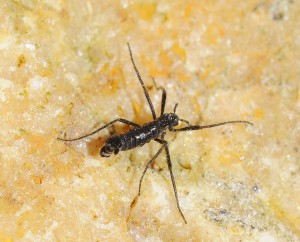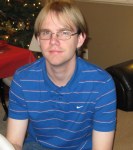Courtney Passow visits Kelley Lab
joanna.l.kelley Courtney Passow is visiting from the Tobler Lab at Kansas State University. She’s spending a few weeks processing samples to extract total RNA and generate RNA-sequencing libraries for a hydrogen sulfide exposure experiment. The goal of the study is to determine which genes are differentially regulated in response to hydrogen sulfide exposure, depending on the source population. Courtney will spend two weeks in the lab honing her molecular skills. We are very happy to have her here!
Courtney Passow is visiting from the Tobler Lab at Kansas State University. She’s spending a few weeks processing samples to extract total RNA and generate RNA-sequencing libraries for a hydrogen sulfide exposure experiment. The goal of the study is to determine which genes are differentially regulated in response to hydrogen sulfide exposure, depending on the source population. Courtney will spend two weeks in the lab honing her molecular skills. We are very happy to have her here!
Corey to give CRB talk
joanna.l.kelleyOur fantastic lab manager, Corey Quackenbush, has been chosen to give one of the presentations at the first annual Center For Reproductive Biology (CRB) Trainee Symposium 2014. Information about the symposium can be found at http://crb.vetmed.wsu.edu/events/crb-trainee-symposium.
Antarctic fly genome
joanna.l.kelley
Happy to share that the Antarctic fly, Belgica antarctica, genome has been published in Nature Communications! We sequenced and assembled the genome of the only insect endemic to Antarctica. The fly has the smallest insect genome surveyed or sequenced to date! While most of the genes in other Diptera are present in B. antarctica, it is notably lacking repetitive elements, including transposable elements. Thanks and congratulations to my co-authors, who all worked hard on assembling, annotating and making sense of this exciting genome!
Links to popular press about the article:
ScienceNews
BBC Nature News
WSU Press Release
Natureasia.com
Phys.org
Yahoo News and here too!
IFLS
Voice of America with a short interview clip
Le Parisien
Visiting student from University of Alabama
joanna.l.kelley We have had the pleasure of having Chris Cornelius from Ryan Earley‘s lab at University of Alabama visiting the lab for the month of July. Chris has extracted RNA from over 130 embryos and generated 20 RNA-sequencing libraries! It was a successful month!
We have had the pleasure of having Chris Cornelius from Ryan Earley‘s lab at University of Alabama visiting the lab for the month of July. Chris has extracted RNA from over 130 embryos and generated 20 RNA-sequencing libraries! It was a successful month!
Kayla receives the J. Herman and Jean Kaye Swartz Memorial Scholarship
joanna.l.kelley Congratulations to Kayla for receiving the J. Herman and Jean Kaye Swartz Memorial Scholarship from the College of Arts and Sciences at WSU. J. Herman Swartz earned his B.S. (1938) and M.S. (1939) in bacteriology from then–WSC. Swartz received a scholarship that changed his life. He believed that any student who wants an education should get that chance—and that the rest of us should help. His wife, Jean Swartz, established this fund in 1997 in his memory. The scholarship is for students in biotechnology who intend to apply their knowledge of biological techniques to develop new products that meet the needs of humans.
Congratulations to Kayla for receiving the J. Herman and Jean Kaye Swartz Memorial Scholarship from the College of Arts and Sciences at WSU. J. Herman Swartz earned his B.S. (1938) and M.S. (1939) in bacteriology from then–WSC. Swartz received a scholarship that changed his life. He believed that any student who wants an education should get that chance—and that the rest of us should help. His wife, Jean Swartz, established this fund in 1997 in his memory. The scholarship is for students in biotechnology who intend to apply their knowledge of biological techniques to develop new products that meet the needs of humans.
Lab trip for ice cream
joanna.l.kelleyIt’s been a hot few day s in Pullman! With the arrival of Chris Cornelius from University of Alabama and Kyle Taylor, a starting Master’s student in the lab, we decided it was time to take a trip to Ferdinand‘s, the campus ice cream shop! The ice cream was delicious!
s in Pullman! With the arrival of Chris Cornelius from University of Alabama and Kyle Taylor, a starting Master’s student in the lab, we decided it was time to take a trip to Ferdinand‘s, the campus ice cream shop! The ice cream was delicious!
Molecular mechanisms of sulfide adaptation
joanna.l.kelleyWe contributed to two papers published this week investigating the molecular mechanisms of adaptation to hydrogen sulfide (H2S) rich environments. In our paper published in Comparative Biochemistry and Physiology A, we show heritable differences in gene expression patterns between sulfide adapted and non-adapted populations. Depending on the organ, sulfide-quinone oxidoreductase (SQR), an enzyme critical to sulfide detoxification, is either constitutively or plastically higher expressed in sulfidic populations. The other paper, published in Nature Communications, also indicated that at least some sulfidic P. mexicana populations exhibit an H2S-resistant cytochrome oxidase (COX), one of the primary targets of H2S toxicity.
Julian receives the J. Herman and Jean Kaye Swartz Memorial Scholarship
joanna.l.kelley Congratulations to Julian for receiving the J. Herman and Jean Kaye Swartz Memorial Scholarship from the College of Arts and Sciences at WSU. J. Herman Swartz earned his B.S. (1938) and M.S. (1939) in bacteriology from then–WSC. Swartz received a scholarship that changed his life. He believed that any student who wants an education should get that chance—and that the rest of us should help. His wife, Jean Swartz, established this fund in 1997 in his memory. The scholarship is for students in biotechnology who intend to apply their knowledge of biological techniques to develop new products that meet the needs of humans.
Congratulations to Julian for receiving the J. Herman and Jean Kaye Swartz Memorial Scholarship from the College of Arts and Sciences at WSU. J. Herman Swartz earned his B.S. (1938) and M.S. (1939) in bacteriology from then–WSC. Swartz received a scholarship that changed his life. He believed that any student who wants an education should get that chance—and that the rest of us should help. His wife, Jean Swartz, established this fund in 1997 in his memory. The scholarship is for students in biotechnology who intend to apply their knowledge of biological techniques to develop new products that meet the needs of humans.
NIMBioS working group
joanna.l.kelleyI spent the week at NIMBioS in Knoxville, TN, with a great group of colleagues. It was an interesting and exhausting week of talking about landscape genomics and generating a plan for the next two years of the working group.
Objectives:
As we move forward in the genomic age, we can rapidly sequence complete genomes and transcriptomes, as well as assay genomic structural features (e.g., gene copy number variants, transposable elements), of virtually any species. Advances in genomics provide new avenues for understanding the genetic basis of functionally adaptive trait variation. For example, we have made great strides in understanding adaptation to extreme environments and the genetic basis for many diseases in human populations, as well as in non-model organisms. However, scientists are awash with data, and methods to unlock the power of genome projects are still under development.
Rapid advances in our ability to obtain genomic data have also caused a paradigm shift in the way we view “genes.” Once thought to be directly related to phenotype, genes operate in complex genomic landscapes, rather than in isolation. A gene’s location and copy number within a genome may regulate its expression, as well as its interaction with other genes and noncoding RNA. The complexity of the genomic landscape is compounded by the environment in which an individual persists. Genes are expressed differently in different environments, and selection varies spatially across the ecological landscape. A major challenge, then, is to analyze data sets that integrate both the genomic landscape and the ecological landscape to understand the spatial distribution of adaptive genetic variation. This working group will address this challenge by advancing analytical and computational methods with an interdisciplinary collaboration of experts in genomics, statistics, mathematics, bioinformatics and population genetics.
http://www.nimbios.org/workinggroups/WG_genomics
